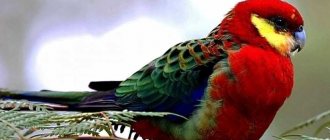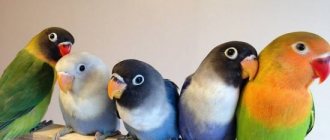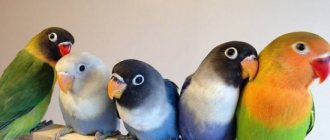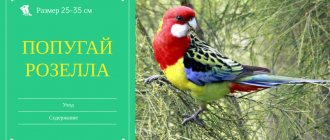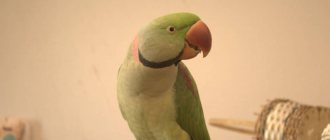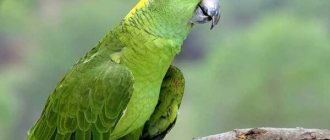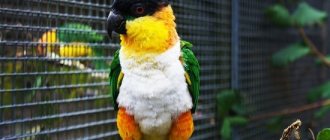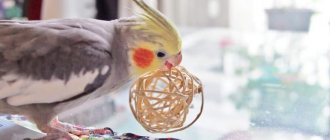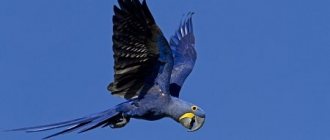Habitat
In nature, grass parrots can be found in the south, south-eastern part of Australia, as well as in the west of the mainland and in the center, in Queensland, Victoria, New South Wales, on the island. Tasmania and the Bass Strait Islands.
Birds prefer wooded areas rich in herbs with undergrowth, dry eucalyptus savannas and arid, semi-arid steppes with sparse vegetation and thorny bushes, meadows, swamps, bays, lagoons and rocky areas.
Photo: David Cook
Each type of grass parrot inhabits an area with a certain landscape, but they are all united by an “earthly” way of life.
The flights of grass parrots are low and over short distances; the birds spend a lot of time on the ground in dense grasses.
The name of this species was given based on its habits: grass parrots spend a significant part of their lives in thickets of grass, looking for various seeds there. Sometimes flocks of grass parrots can be found in farmers' fields and gardens, but there are no complaints about pests.
Spending a lot of time on the ground, grass parrots have adapted to move deftly over uneven surfaces and ditches, and to run quite quickly.
Some subspecies of grass parrots are endangered and are protected by Australian laws.
The main food for parrots in the wild is a variety of seeds of meadow and steppe grasses: wild canary grass, kangaroo grass, clover; they also like to eat the fruits of wild bushes, fruits and sometimes even insects.
Peculiarities
Unlike many of their relatives, parakeets move primarily on the ground, and fly only in exceptional cases. In nature, they perfectly navigate in dense grass, preferring to fly only to the height of the bush. To keep them permanently at home, it is advisable to purchase a spacious enclosure at least 1 meter in length.
Grass parrots are quite friendly and easy to tame. Despite the fact that the bird is constantly moving, it does not make excessive noise. Grass parrots reproduce well in captivity - a female can lay eggs 1-2 times in a year. Childbearing age occurs at approximately 8-9 months, but experts do not recommend mating birds before they are one year old.
In order for the birds to feel comfortable, it is not recommended to place more than one pair in one enclosure, as adult males begin to quarrel with each other.
Description and types of grass parrots
Grass parrots belong to the genus (Neophema), which includes seven species (although some researchers classify Neophema bourki as a separate species):
- Pink-bellied (Bourka) grass parrot (Neophema burkii)
Photo: Zeetz Jones - Glossy (red-breasted) grass parrot (Neophema splendida) - in nature the population is small, therefore artificial propagation is actively supported by ornithologists, it is included in the Red Book.
Photo: Roger Smith - Decorated (elegant) grass parrot (Neophema elegans)
Photo: Dave Curtis - Golden-bellied (orange-bellied, golden-bellied) grass parrot (Neophema chrysogaster) – is protected by Australian laws and is listed on CITES Appendix 1.
Photo: Ron Knight - Blue-winged grass parrot (Neophema chrysostoma) – rare, can only be found in private nurseries, is protected.
Photo: Wayne Butterworth - Rock (stone) grass parrot (Neophema petrophila) - extremely rare as a domestic parrot, protected by Australian laws.
Photo: jacksnipe1990 - Azure grass parrot (Neophema pulchella)
Photo: Tim Ellis
All species of grass parrots have artificially bred new color variations.
The most popular among fans are: pink-bellied, azure, glossy and elegant parrots.
The bird's body size is 21-25 cm, the main color is green with a wide variety of tints, the only exception is the pink-bellied species - their plumage completely lacks green color.
Grass parrots are crepuscular birds whose active period occurs in the mornings and evenings. If during the day grass parrots are practically not seen or heard, then in the evening the birds begin to rush around the cage with pleasure, flying from one end of the cage to the other, using the lower perches.
Despite the fact that parakeets have some external resemblance to budgies, their behavior, habits and relationships with each other are strikingly different.
Photo: Markus Schroeder
Azure parakeets are very popular as pets. The birds have a calm, balanced character and are quite good at taming.
This type of bird is prone to obesity, so be very careful when choosing a menu for the bird and its participation in daily flights. They are also easily tamed and willingly make contact with humans.
Glossy grass parrots are considered the most beautiful. This is one of the favorite parrots of breeders. The birds are endowed with all the positive qualities of this species and are endearing to you from the first minutes of their acquaintance.
What to feed?
At home, parrots eat a grain mixture. Food for canaries, oatmeal and other cereals, millet, and sunflower seeds are quite suitable. The main thing is not to overfeed the bird. An adult bird needs about one and a half tablespoons of feed per day. Parrots happily eat finely chopped or grated vegetables and fruits, and various greens.
In the first months of life, chicks need to be given animal protein. It is found in various insects: bloodworms, worms, etc.
Reproduction
Adult parrots have pronounced sexual dimorphism. Having opened the bird's wing, the female has a white stripe on the inside; males do not have this.
But due to the frequent mixing of species to obtain new colors, such a difference in some cases may be either not pronounced or completely absent. Then fanciers resort to other methods of determining the sex of birds (observation of behavior, DNA test).
During the mating season, males become more aggressive, so for safe reproduction, it is better to place the couple in a separate enclosure. Successful breeding results can be achieved not only by placing a couple in an outdoor enclosure, but also by creating optimal conditions indoors.
Puberty in grass parrots occurs at 8-9 months, but it is better to prepare a pair after one year of age. During the mating season, the male begins to court the female, becomes affectionate and “invites” her to the nesting house.
Photo: Ralph Green
Nesting occurs in birds 2-3 times a year from August to December (this applies to wild parrots). For domestic grass parrots, it is better to provide conditions in the spring and summer.
The female incubates 3 to 6 eggs for about 20 days, after which the couple feeds the chicks for a month. Please note that grass parrot chicks are very shy! Clean the cage carefully, trying not to disturb the young animals.
Reviews from the network
Irina
My azure parakeet is already two years old. He is very beautiful, his breast is bright red and his back is green. It chirps a lot, but it doesn’t bother me at all, because the sound is pleasant. And it’s good that he feels good, since he constantly sings. I feed him a homemade mixture of wheat, millet and oats. I also give spinach and salad. He really likes apples as a fruit. I give them straight to the skin, just wash them first, of course.
Keeping parakeets at home is not as easy as keeping budgies. They require conditions close to their natural habitat in Australia. However, grass parrots successfully adapt to home environments and people.
Keeping grass parrots at home
For quite a long time, bird lovers have been faced with the problem of providing grass parrots with normal living conditions in captivity and their further breeding. It got to the point that they decided to consider this species of parrots as intolerant of life in a cage, very capricious and weak. But the hard work of some ornithologists was not in vain.
Parrots came to Russia in 1975 from Germany (GDR).
Grass parrots should be kept in spacious cages or aviaries , in a warm, well-ventilated room, but without drafts.
One of the main enemies of grass parrots is draft!
Artificial lighting
The room itself should be bright with access to sunlight.
Photo: David Cook
Grass parrots are considered crepuscular birds, so it is important to pay attention to artificial lighting in the cage.
Use two additional lighting modes:
- the first light source will maximally replace summer sunbathing, which is impossible in winter. You can also use an electric lamp to regulate the length of the bird’s daylight hours.
- the second mode should be used at the end of the day, switching to a more subdued and calm light for 3-4 hours. An 18 W light bulb is enough for this.
Parrots are shy birds and sudden plunges into darkness can make them anxious and stressed. Moreover, they become very active at the end of the day, and turning off the light will not allow the birds to lead a natural and healthy lifestyle.
Conditions in captivity
Comfortable air temperature for parrots is 18-20° C, humidity should also be controlled, it should not be lower than 50-60%. Cold and damp are destructive for birds!
Grass parrots, like other species, need to be allowed out for walks. This will protect the birds from many diseases and will help you establish contact with the birds.
The cage, or more precisely its size, is also responsible for the good health of the birds. Grass parrots love to spend a lot of time on the ground, so the cage should be as long as possible. If you plan to breed birds, then choose a house for a couple with dimensions: length 100-150 cm, height up to 100 cm, width 50-80 cm.
Grass parrots love to run on the ground, so it is of course better if, in addition to walking, the birds have space for running and short flights from perch to perch.
Parrots are very sensitive during the adaptation period (the first days in the house), but later they become unpretentious and pleasant roommates.
If your birds have not yet completely gotten used to it or are scared of something, try whistling softly. The parrots noticeably calm down and thus your contact with them allows you to adapt faster.
It is very important to create optimal conditions initially and then the birds will delight you for many years. By following the rules of keeping, birds can live up to 20 years.
How to maintain?
Since these birds come from the tropics, their conditions in captivity should be close to natural ones. The room with the bird aviary should be warm, without drafts. The optimal temperature is +20 degrees Celsius, and air humidity is at least 60%. Activity in grass parrots begins in the afternoon. During the day the bird hardly moves, but towards sunset it begins its trills, producing them in its not very loud, but rather pleasant and melodious voice.
Therefore, in the evening you should take care of additional lighting . The bird is very shy, so the transition from daylight to evening light must be done smoothly. The sudden onset of darkness can cause stress in the bird. It is believed that a quiet whistle can calm an agitated bird, but loud sounds, on the contrary, are very exciting and irritating. When properly maintained, grass parrots in captivity live on average 12-15 years, in some cases they lived up to 20 years.
Nutrition
In the wild, the main food of grass parrots is seeds and young shoots of various grasses. At home, food should also be fresh and of high quality.
Photo: Jan Tik
The main components of grain feed: millet (all types), chickpeas, oatmeal (not flakes), sunflower, flax, canary seed, wheat, hemp, ryegrass, bluegrass, sudanese, barnyardgrass.
The first six types of grains should always be present, the rest depending on the season and the natural needs of the birds (breeding period, molting, active flights, feeding chicks). Grain can be given in different ripeness, as well as sprouted and soaked.
Among the greens, birds really like dandelion, chicory, shepherd's purse, knotweed, lettuce, spinach, quinoa, clover and wormwood. Also offer fruits, vegetables, berries, young ears of corn, sunflower caps, twigs from bushes and trees with buds. To maintain young birds, they are given mealworms, eggs and cottage cheese.
It is safe to say that if you decide to purchase a pair of grass parrots, you will not regret it. Rarely did anyone settle on one feathered family and later they always acquired several more.
Grass parrots are unpretentious, calm and very peaceful birds. You will get tremendous pleasure watching them and participating in their lives.
Memorable appearance
At the moment, 7 subspecies are classified as grass parrots. They all have characteristic external differences and common features. Thus, the predominance of green color in the plumage is considered a feature that unites all subspecies. The exception is the pink-bellied subspecies, which does not have a single shade of green in its plumage.
An adult grass parrot reaches about 23 centimeters in length. It has a small curved beak designed for catching small insects, picking fruits and extracting seeds. The parrot's head is small, depending on its species, it can be decorated with spots of color that contrasts with the main plumage.
The wings are medium in size and poorly developed, so the bird flies short distances, taking breaks. Some subspecies have a brightly colored abdomen, others have a breast or wings. Grass parrots differ from their counterparts in having well-developed legs. Since most of their lives they move on the ground practically at a run, their legs are much stronger than their wings. With their help, they can cross uneven terrain, ditches and swampy areas.
Varieties
There are 7 species of grass parrots in total, each of which has its own unique coloring. Let's look at each of these types in more detail.
Pink-bellied
The Pink-bellied Parrot, also known as the Bourka. Scientific name Neophema bourkii. The size of the bird is about 23 cm, the length of the tail is about 10 cm. The plumage of this individual has a brown tint, the abdomen is colored red-pink. The female has white feathers on her cheeks, and the male has a blue spot on his forehead. In nature, the pink-bellied parrot builds nests in tree hollows. The female can lay 3-5 eggs at a time, which she incubates for 2-3 weeks.

